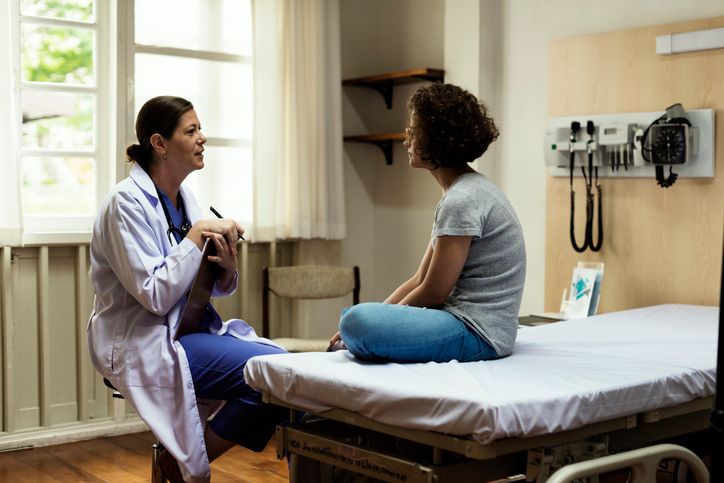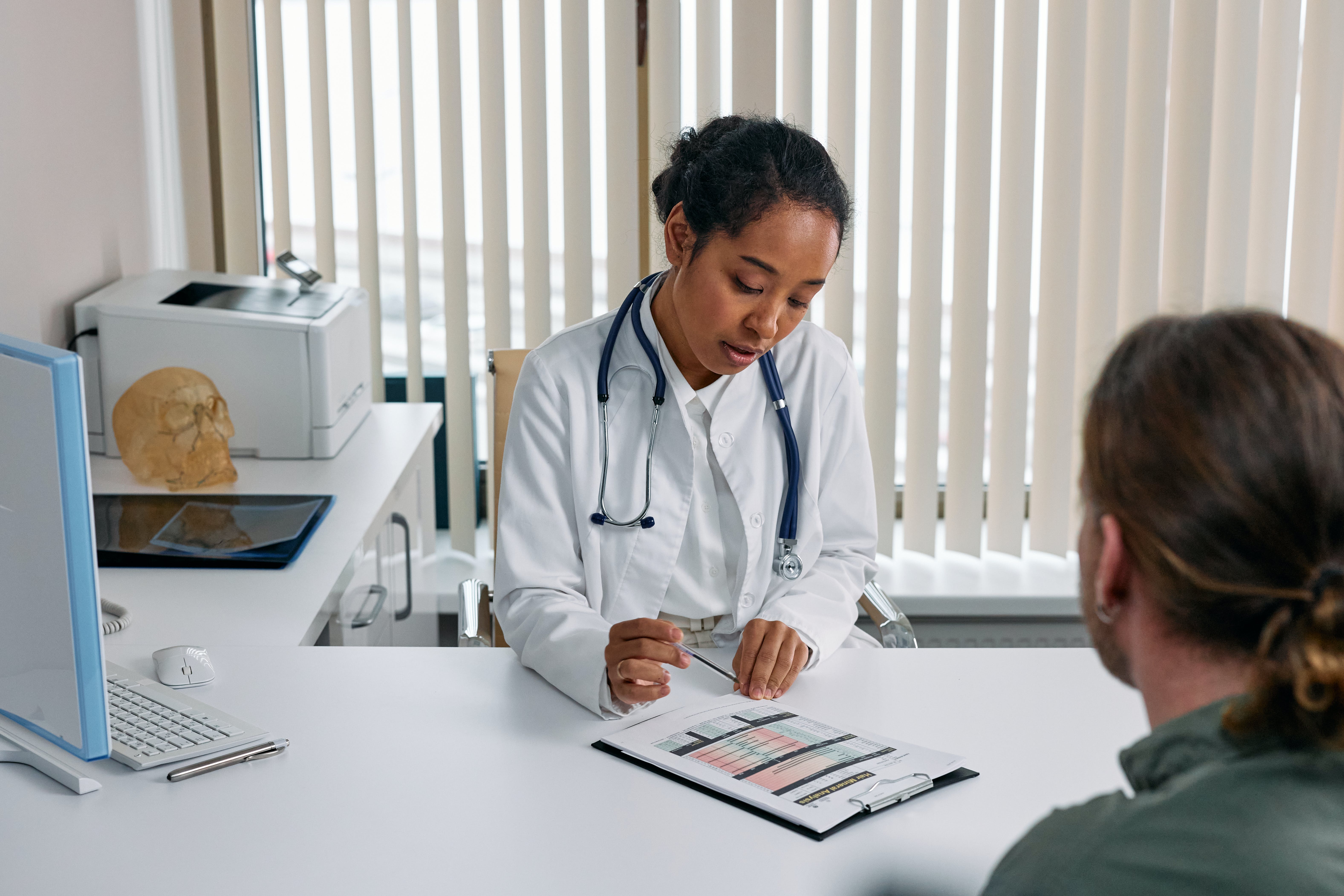


Eating disorders often hide in plain sight, going unnoticed and undiagnosed for weeks, months, or even indefinitely. This is concerning, given the fact that eating disorders have the second highest mortality rate of all mental illnesses, and that the longer someone has an eating disorder, the tougher it is to recover. One important way to address this problem is by educating primary care providers on how to identify eating disorders, and what to do if they’re concerned about a patient.
Read on to learn more about the important role primary care providers play in spotting eating disorders and helping patients find support.
Why primary care providers need to look out for eating disorders
Eating disorders are common and deadly. According to a meta analysis of 94 studies, the lifetime prevalence of eating disorders were 8.4% for women and 2.2% for men, and these rates have been rapidly increasing over the past few decades, especially among young people and marginalized groups. What’s more, the actual numbers are likely even higher than those reported, since many eating disorders go undiagnosed. Experts estimate that due to lack of awareness and insufficient methods for diagnosing eating disorders, anywhere from 50% to 80% of these illnesses go undetected or are misdiagnosed as something else. And even if someone is diagnosed, there are still significant barriers to treatment that keep people from getting better: according to research, only one in four people with eating disorders seek help.
Primary care providers play a critical role in helping to close this gap and get more people the care they need. Not only are PCPs in a position to spot concerning signs and symptoms before others might, medical management by an informed provider is also an essential part of eating disorder treatment. Eating disorder experts have recommended that primary health care settings put in place an early intervention model to address eating disorders, and the United States Preventive Services Task Force published a recommendation on screening for eating disorders among adolescents and adults in primary care.
Adam Arsenault, RN, MSN a psychiatric nurse practitioner at Equip, agrees with these recommendations, elaborating on the important role of PCPs in recognizing eating disorders. “Often with adolescents, the primary care setting is the first instance that families are made aware that something is ‘not right’ with their child, such a drastic weight change or abnormal vitals signs and labs,” he says. “Adults with eating disorders may have been struggling with their disorder for prolonged periods of time, and the PCP may be the first provider to meet with the patient and recognize symptoms. Early recognition of eating disorders is critical, because these conditions are associated with significant morbidity and mortality. Primary care providers play a key role in early identification, which can lead to timely interventions.”
Why eating disorders often go undetected at the doctor’s office
Eating disorders are self-protective illnesses that tend to be hidden by nature. Symptoms and behaviors that might be obvious red flags—like binge eating, purging, compulsive exercise, or restricting food—usually occur in private, and those who are struggling often go to great lengths to hide their disorder. This is partly due to the shame and stigma that often comes with these illnesses, and partly due to the fact that many people with eating disorders don’t actually want to get better (which is what we mean when we describe eating disorders as being egosyntonic). The secretive nature of these illnesses can make it difficult for PCPs or other providers to detect them.
There are also societal and systemic factors that prevent PCPs from identifying eating disorders in their patients. For one thing, due to lack of awareness on the many ways that eating disorders show up, providers may associate eating disorders with a specific type of person (usually white, thin, young, and female) or a specific set of symptoms, like binging and purging or extremely restrictive eating. In reality, eating disorders affect people of all ages, genders, races, and body types, and they show up in a wide range of different psychological, physical, and behavioral symptoms.
“Various barriers impede PCPs from identifying eating disorders, including stigma associated with mental health, weight biases, lack of specific training in recognizing these disorders, and misconceptions about the patient population affected,” says Arsenault. “Someone in a larger body may not be screened and identified with an eating disorder due to the provider’s belief that only those who are underweight have eating disorders.
Why is early intervention critical in eating disorder management?
A large body of research suggests that the earlier someone gets help for an eating disorder, the better their outcomes. The opposite is also true: the longer somebody struggles with an eating disorder, the more difficult it is for them to recover and the likelier it is that they’ll experience long-term consequences for their mental or physical health.
“Studies have shown that patients who receive prompt treatment have better outcomes, demonstrate higher rates of remission and a decreased likelihood of developing chronic eating disorders,” says Arsenault. “Furthermore, early intervention can mitigate the impact of eating disorders on overall quality of life and functioning. Evidence suggests that addressing eating disorders at an early stage can facilitate healthier coping mechanisms and resilience in patients, ultimately leading to improved self-esteem and social functioning.”
Indeed, research shows that intervening and improving symptoms early decreases a person’s risk of struggling with an eating disorder long-term, and there’s reliable evidence that early intervention improves a person’s chance of achieving full, lasting recovery. One large meta analysis also found that early intervention programs have been shown to significantly reduce risk factors and encourage help-seeking behaviors.
Besides improving the odds of recovering from the eating disorder, early intervention also helps prevent long-term physical or psychological consequences of the illness, as well as recovery from any co-occurring conditions. “Early intervention helps prevent the progression of the disorder, which can lead to severe physical and psychological complications, including cardiovascular issues, metabolic imbalances, and increased risk of comorbid mental health conditions such as anxiety and depression,” says Arsenault. Research shows that identifying any co-occurring conditions and addressing them early, alongside the eating disorder, can be another key to effective and lasting recovery.

What are the early signs of eating disorders in primary care?
Eating disorders show up in many different ways, and the same diagnosis can look different from person to person. However, there are a number of signs that PCPs should be on the lookout for that are cause for alarm.
Common physical signs of an eating disorder
Some physical signs that PCPs might notice in patients are:
- Weight loss or fluctuations
- In growing children, falling off the growth curve or gaining weight at a slower rate
- Orthostatic vital signs
- Abnormal electrolytes
- Abnormal cardiac rhythms
- Dental enamel erosion
- Russell’s sign (calluses on the knuckle from repeated purging)
- Lanugo (fine, soft hair on the body)
- Dizziness/episodes of syncope
- Gastrointestinal complaints
- Menstrual irregularities
Common behavioral signs of an eating disorder
While PCPs likely won’t directly observe any disordered behaviors, they can ask questions—both in conversation and in questionnaires—to try to identify troublesome habits. Some behaviors that might indicate an eating disorder include:
- Hiding food
- Avoidance of family meals/social eating situations
- Social withdrawal
- Excessive exercise
- Exercising secretly
Common psychological signs of an eating disorder
PCPs may be able to directly observe some of psychological symptoms that might indicate an eating disorder, as well as ask questions that might bring them to light. These symptoms include:
- Preoccupation with food or body image
- Anxiety
- Depression
- Obsessive thoughts about food
- Body image distress
How can primary care providers screen for eating disorders?
It’s essential that PCPs know how to screen for eating disorders in their patients. Screening helps prevent these life-threatening illnesses from going undetected, and improves treatment outcomes by catching eating disorders early. Thankfully, there are a number of evidence-based screening tools that providers can use to identify potential eating disorders in their patients.
Screening tools and practical questions
During well visits and check-ups, it’s important for PCPs to ask patients practical, non-invasive questions about their relationship to food, exercise, and their body. This is important for all patients, but is especially critical in high-risk populations, like teens and adolescents. Some potential questions might include:
- Have you made any changes in your eating habits?
- Do you feel in control of your eating?
- What’s your relationship with exercise like?
- How do you feel about your weight?
- What do you like about the way that you eat? What do you dislike?
- Would it be okay if we discussed your eating habits?
PCPs should also consider using an evidence-based eating disorder screener. One of the best options is the SCOFF questionnaire, which is a simple five-question assessment. If a patient answers “yes” to two or more questions, it may indicate the presence of an eating disorder.
SCOFF questions:
S: Do you make yourself Sick because you feel uncomfortably full?
C: Do you worry you have lost Control over how much you eat?
O: Have you recently lost more than One stone (6.35 kg) in a three-month period?
F: Do you believe yourself to be Fat when others say you are too thin?
F: Would you say Food dominates your life?
There are a number of other eating disorder screening options, which are outlined thoroughly in this article on screening for eating disorders. Some of the most commonly used screeners include:
- Eating Disorder Screen for Primary Care (ESP)
- Eating Disorder Examination Questionnaire-7 (EDEQ-7)
- Nine Item ARFID Screen (NIAS)
Providers should incorporate screening tools early, and integrate behavioral health screeners into existing medical screeners, like growth charts. It’s important to recognize that screening doesn’t mean a diagnosis, but indicates the need for further assessment.
Diagnostic approaches: physical examination and lab work
Besides screeners and practical questions, PCPs should also look for physical indicators that a patient is dealing with an eating disorder. This can include things to look out for during a physical exam—such as dental erosion, calluses on the knuckles, and unstable vitals, among the other physical signs of an eating disorder outlined above—as well as specific labs to order.
“PCPs should consider lab tests to check electrolyte imbalances. In addition to baseline complete blood count and comprehensive metabolic panel, testing for magnesium and phosphorus can assist in eating disorder detection and prevention of refeeding syndrome,” advises Arsenault. Other tests experts recommend include testing FSH, LH, and TSH levels (in the case of amenorrhea); running an EKG (especially important in patients who are bingeing and purging); and performing a bone density scan.
Best practices for PCPs: supporting patients with eating disorders
No matter what population PCPs work with, it’s important that they are knowledgeable about eating disorders and how to support patients who might be struggling. Besides learning about warning signs and screening practices, this also involves creating a safe space for patients with eating disorders and having resources ready when somebody needs support.
Creating a supportive and non-judgmental practice environment
Eating disorders tend to be shrouded in shame and guilt, making it difficult for patients to voice their concerns or ask for help. This is often exacerbated by diet culture and weight stigma, which can cause those who are struggling to fear judgment about their behaviors—especially if they’re in larger bodies or engage in binge eating behaviors, which diet culture paints as a moral failing. PCPs can help counter this by creating a supportive environment that encourages patients to discuss their eating behaviors without fear of judgment or being reprimanded.
Here are some strategies for creating an environment that feels safe for eating disorder patients:
- Educate those in your office about eating disorders
- Learn about the Health at Every Size (HAES) approach
- Remember that eating disorders affect people of all body sizes
- Watch how you speak about bodies, food, and exercise
- Become aware of the different ways that weight stigma shows up in healthcare settings
- Ask questions from a place of curiosity, rather than judgment
Knowing when—and how—to refer patients
While it’s essential that PCPs become educated about eating disorders, it’s important that those struggling with these illnesses work with eating disorder specialists. Primary care providers are often involved in treatment in some capacity, but effective eating disorder care involves working with a multidisciplinary team of specialists who are specifically trained in eating disorders. For this reason, it’s important that PCPs develop relationships with eating disorder-trained dietitians and therapists, as well as eating disorder treatment programs they can refer patients to.
“If a PCP suspects an eating disorder, they should approach the patient with empathy, provide psychoeducation, and refer them to specialists such as dietitians, therapists, and eating disorder clinics for comprehensive treatment,” says Arsenault. “There are multiple levels of eating disorder treatment including residential treatment centers, partial hospitalization programs (PHP), intensive outpatient programs (IOP), and virtual outpatient treatment such as Equip.” While every patient has their own unique needs, Equip is an appropriate treatment option for patients of all acuity levels, as long as they’re medically stable.
In addition to having referral options readily available, PCPs should also feel confident in determining when to refer patients to specialized care. Some signs that a patient needs to be referred to eating disorder treatment include rapid weight loss, significant mood changes, or when the patient’s disordered behaviors or thoughts are interfering significantly with their life. Learn more about how to know when it’s time to refer a patient.
In cases where the eating disorder has significantly impacted a patient’s physical health, they may need to be referred for inpatient hospitalization before they’re ready for treatment. “If the patient is medically at at risk—bradycardia less than 45 BPM, an ideal body weight under 75%, electrolyte imbalance, acute food refusal for 48 hours, or orthostatic vitals—the PCP may want to recommend going to the emergency room for evaluation for an inpatient hospitalization,” advises Arsenault. Learn more about how to tell if a patient needs inpatient hospitalization.
The Equip takeaway: PCPs are key to early eating disorder intervention
Primary care providers play a central role in detecting eating disorders and helping patients get the care they need to achieve lasting recovery. Here are the key things all PCPs should remember about eating disorders:
- PCPs are often in a position to spot signs of eating disorders before other people in a patient’s life. Because early intervention leads to better outcomes, it’s essential that PCPs become educated on the early signs of eating disorders and how to refer patients to treatment.
- Many barriers prevent PCPs from identifying eating disorders in their patients. Some of those barriers include lack of education and awareness about eating disorders, weight stigma and diet culture, and the self-protective nature of eating disorders.
- PCPs should become educated about some of the early signs of eating disorders that might show up during well checks and exams, such as weight loss, unstable vitals, abnormal electrolyte levels, shifts in mood, irregular cardiac rhythms, enamel erosion, and gastrointestinal complaints, among others.
- Experts recommend that PCPs regularly screen for eating disorders in their patients. They can do so by asking practical, nonjudgmental questions about their patients’ eating and exercise habits, as well as their attitude toward their body and weight. They can also integrate evidence-based eating disorder screening tools, such as the SCOFF questionnaire.
- It’s important for PCPs to create a supportive and nonjudgmental environment in which patients feel comfortable voicing concerns they may have about disordered eating habits. This can include learning about the HAES approach and addressing any weight bias or diet culture-informed beliefs they may hold.
- In order to best support patients, PCPs should develop relationships with eating disorder-informed dietitians, therapists, and other providers, as well as evidence-based eating disorder treatment programs. Effective eating disorder treatment involves working with a multidisciplinary team specifically trained in eating disorders.
Get in touch to learn more about Equip’s evidence-based, fully virtual eating disorder treatment and how we work with referring PCPs.
FAQ
What are the early signs of eating disorders that PCPs should look for?
Primary care providers are often in a position to spot symptoms of eating disorders that others might miss, making it essential that they know the early signs to look out for. PCPs should look out for physical signs like weight loss, unstable vitals, abnormal electrolyte levels, irregular cardiac rhythms, enamel erosion, and gastrointestinal complaints, among others. They should also look out for and ask questions about psychological and behavioral symptoms, such as preoccupation with body and weight, social withdrawal, excessive exercise, feeling out of control around food, restrictive eating, and body image distress.
How can PCPs effectively screen for eating disorders in their practice?
Experts recommend that PCPs regularly screen for eating disorders in their patients. They can do so by asking practical questions, using evidence-based screeners, and/or ordering lab tests. Practical questions may include nonjudgmental questions about a patient’s eating and exercise habits and their attitude toward their body and weight. Screening options include the SCOFF questionnaire, the NIAS, and the EDEQ-7. Lab tests to order include a CBC, electrolyte levels, EKG, and hormone tests.
Why is early intervention so important in the treatment of eating disorders?
A large body of research shows that early intervention in eating disorders leads to better outcomes. Those who get treatment early have a higher likelihood of achieving recovery and remaining in remission, as well as a lower risk of experiencing negative physical or psychological consequences from the eating disorder.
What are the best practices for referring patients with eating disorders to specialized care?
Effective eating disorder treatment requires working with a multidisciplinary care team of eating disorder specialists. PCPs should develop relationships with eating disorder-informed dietitians, therapists, and other providers, as well as evidence-based eating disorder treatment programs. They should also become educated about how to determine when to refer a patient to treatment and when a patient needs inpatient hospitalization.
- Galmiche, Marie et al. “Prevalence of eating disorders over the 2000-2018 period: a systematic literature review.” The American journal of clinical nutrition vol. 109,5 (2019): 1402-1413. doi:10.1093/ajcn/nqy342
- Pastore, Maria et al. “Alarming Increase of Eating Disorders in Children and Adolescents.” The Journal of pediatrics vol. 263 (2023): 113733. doi:10.1016/j.jpeds.2023.113733
- Baranauskas, Marius et al. “Potential Triggers for Risking the Development of Eating Disorders in Non-Clinical Higher-Education Students in Emerging Adulthood.” Nutrients vol. 14,11 2293. 30 May. 2022, doi:10.3390/nu14112293
- Hyam, Lucy et al. “"Early intervention isn't an option, it's a necessity": learning from implementation facilitators and challenges from the rapid scaling of an early intervention eating disorders programme in England.” Frontiers in health services vol. 3 1253966. 18 Jan. 2024, doi:10.3389/frhs.2023.1253966
- Koreshe, Eyza et al. “Prevention and early intervention in eating disorders: findings from a rapid review.” Journal of eating disorders vol. 11,1 38. 10 Mar. 2023, doi:10.1186/s40337-023-00758-3
- Walsh, J M et al. “Detection, evaluation, and treatment of eating disorders the role of the primary care physician.” Journal of general internal medicine vol. 15,8 (2000): 577-90. doi:10.1046/j.1525-1497.2000.02439.x







